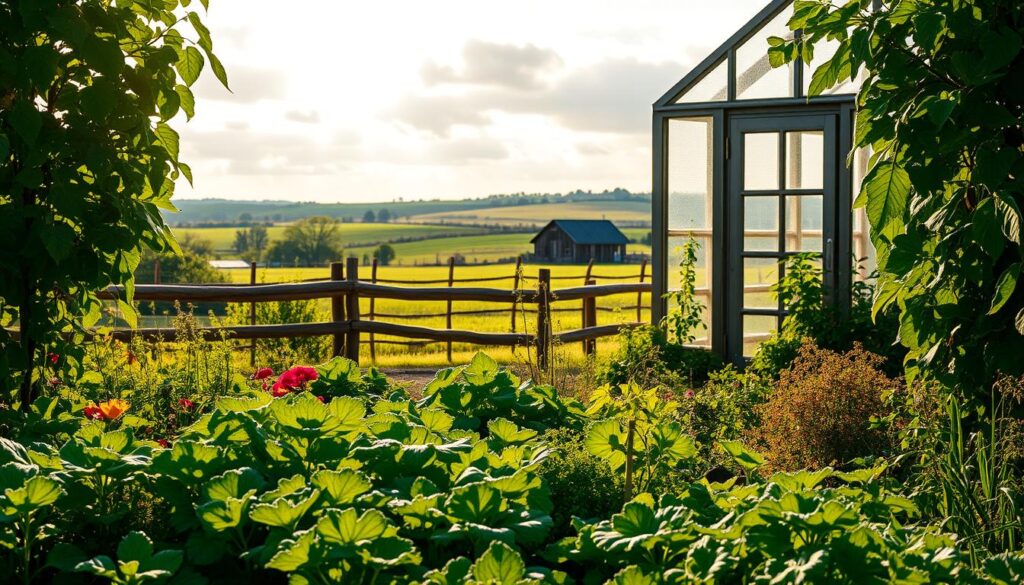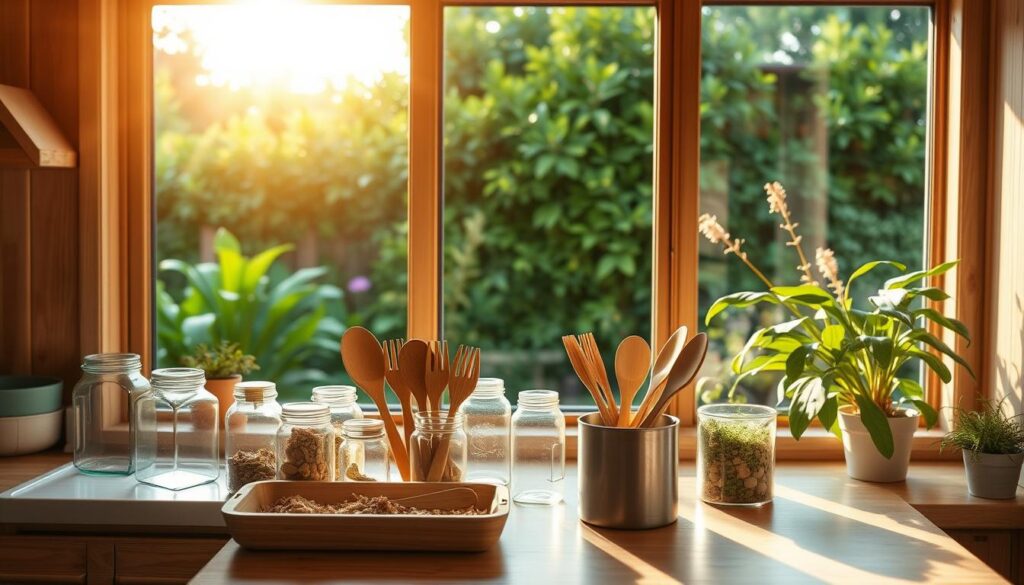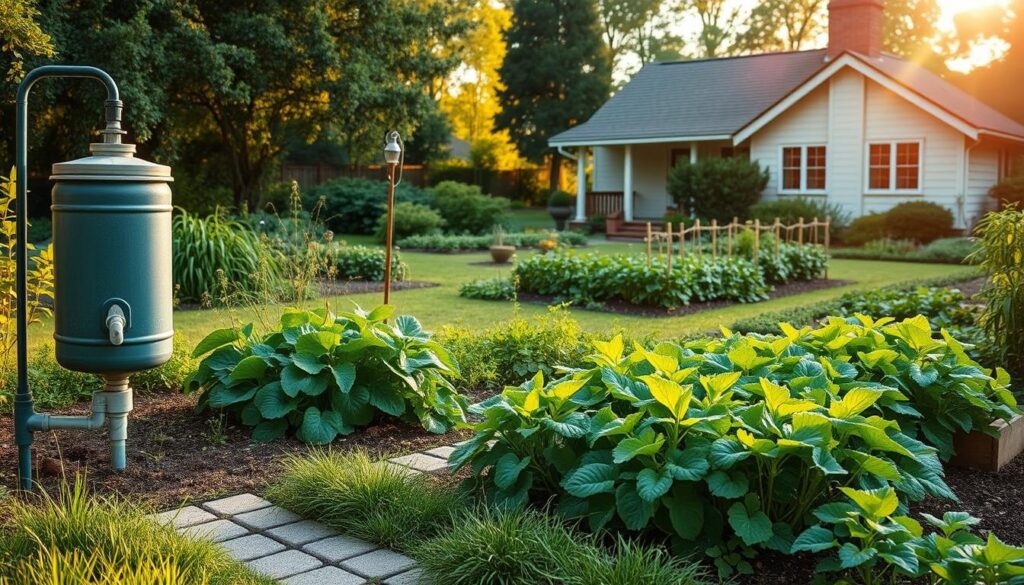Many think going green is costly. But, eco-friendly living can actually save us money. By adopting simple green habits, we can lower our expenses and help the planet. From growing organic food to using energy-efficient appliances, we make a big impact. These actions also lead to savings, like lower bills from using solar power and LED lights.
Making small changes towards sustainability helps both the environment and our wallets. Choosing natural cleaners or a plant-based diet saves money and reduces our carbon footprint. We invite you to explore how eco-friendly habits benefit both your budget and the Earth.
- Key Takeaways
- Growing Your Own Food: The Starter’s Saving Grace
- Transportation: Environmentally Conscious Choices
- Adopting a Zero-Waste Lifestyle: Tips and Tricks
- Eco-Friendly Habits Budget: Maximizing Savings with Minimal Impact
- Solar Energy: Harnessing the Sun’s Power for Your Home
- Minimalism in Consumption: A Budget-Friendly Approach
- Water Conservation Tactics for the Frugal Environmentalist
- DIY Natural Cleaning Products: Safe, Effective, and Economical
- Switching to a Plant-Based Diet: Environmental and Financial Benefits
- Green Tech Investments: Reducing Energy Bills and Carbon Footprint
- Conclusion
- FAQ
- How can I save money by adopting eco-friendly habits?
- What are some budget-friendly green initiatives I can start at home?
- Is it possible to maintain an environmentally conscious lifestyle while on a tight budget?
- Can green technology be affordable?
- How does minimalism contribute to a budget-friendly and eco-friendly lifestyle?
- What are some simple water conservation tips that won’t affect my budget?
- Are there eco-friendly transportation options that are also budget-friendly?
- How does a zero-waste lifestyle save money?
- Can DIY natural cleaning products be as effective as store-bought ones?
- How does a plant-based diet lead to savings and environmental benefits?
- What are the benefits of solar energy for those living on a budget?
- Are LED lights and energy-efficient appliances worth the investment?
- What is smart home technology and how can it assist in frugal, green living?
Key Takeaways
- Adopting eco-friendly habits can lead to significant savings, dispelling the myth that a green lifestyle is costly.
- Simple switches like energy-efficient lighting and harvesting rainwater can be surprisingly effective in reducing utility bills.
- Growing your own food not only assures chemical-free nutrition but also lessens the strain on your wallet.
- Using solar energy can be a smart financial investment, with the potential to dramatically cut energy costs over time.
- Minimalist living reduces clutter and expenses, showing that less can indeed be more in terms of both waste and expenditures.
- Conscious consumption prioritizes necessity over desire, ensuring your purchases support sustainable practices and financial well-being.
Growing Your Own Food: The Starter’s Saving Grace
Starting a garden is a big step towards frugal eco-friendly living and sustainable living practices. It encourages self-reliance and helps the environment by cutting down on the need for store-bought produce. Plus, it means we can enjoy fresh, pesticide-free veggies from our own backyards. Here’s how to make green living hacks a part of our everyday life by gardening.

Gardening is great for sustainable living practices. It lowers our carbon footprint by reducing our need for store-bought fruits and veggies. It also lets us control what goes onto our plants, avoiding harmful chemicals. Growing our food makes us healthier and saves money on groceries, leading to a more frugal eco-friendly lifestyle.
Here are some green living hacks to boost our garden’s output. Using kitchen leftovers for compost makes a great organic fertilizer, improving soil naturally. And collecting rainwater helps save on water use, important for eco-friendly gardening.
Sharing our garden’s produce with the neighborhood builds community and spreads green habits. Working together can create larger green areas and even group gardens. This way, gardening is more than just growing food; it plants the idea of a community-based, sustainable lifestyle.
Transportation: Environmentally Conscious Choices
Every day, the way we choose to travel affects both our wallets and the Earth. To help the planet and save money, try using bikes or public transport instead of driving alone. This not only reduces costs but also cuts down on pollution.
Replacing Car Rides with Biking or Public Transit
Riding a bike is great for the environment and your budget. It saves you money on gas and keeps your car from wearing out too quickly. Plus, it’s good for your health and the planet. Public transport, on the other hand, shares the cost and pollution among many people. This approach highlights the power of community and living sustainably.

Carpooling and Remote Work as Eco-Friendly Alternatives on a Budget
If you need to travel by car, consider carpooling. It’s an easy way to be more eco-friendly and economical. Carpooling lowers the cost of gas for each person and reduces the amount of pollution. Also, working from home means no commute at all. This saves a lot of time and helps the environment by cutting down on emissions.
| Transportation Mode | Cost Impact | Eco Impact |
|---|---|---|
| Biking | Low cost, no fuel required | Zero emissions, low space usage |
| Public Transit | Moderate cost, shared by many | Reduced emissions per capita |
| Carpooling | Split costs of fuel and maintenance | Lower emissions compared to single use |
| Remote Work | No commute costs | No direct emissions |
Think about how you get around every day. Choosing budget-friendly green initiatives not only saves money but also helps our planet stay healthy.
Adopting a Zero-Waste Lifestyle: Tips and Tricks
Choosing a zero-waste lifestyle helps us live more environmentally friendly on a budget. It’s about making smart green choices that have a big impact. By reducing waste, our environmental footprint shrinks, making our lives more frugal and eco-friendly.

From Reducing to Reusing: The Power of Second-Hand
Adopting a zero-waste lifestyle often starts with second-hand shopping. Environmentally friendly platforms like FreeCycle let people share goods for free. This keeps items out of landfills and saves money. By choosing pre-owned items, we extend their usefulness, decreasing the need for new products.
Composting: Turning Waste into Resource
Composting is key to sustainable living. It lets us turn organic waste into compost, reducing landfill trash. This compost improves our garden soil, helping plants grow better. Adding composting to our routine is a powerful frugal environmental practice.
Eco-Friendly Habits Budget: Maximizing Savings with Minimal Impact
Starting with sustainable living tips does not mean giving up a good life. By adding simple, eco-friendly habits to our routine, we can save money and help the planet. Think about unplugging devices when they’re not in use. Or using items that last longer instead of throwing them away. These easy steps can have a big impact on our wallets and the Earth.

Planning meals and shopping at local farmers’ markets are smart ways to save money and eat fresh. When we buy food in large amounts from these markets, we spend less and cut down on trash. These actions support a lifestyle that’s good for our bank account and the Earth.
| Action | Benefits | Estimated Savings |
|---|---|---|
| Unplugging Appliances | Reduces Energy Consumption | $100/year |
| Reusable Products | Decreases Waste Production | $150/year |
| Meal Planning | Minimizes Food Waste | $1,200/year |
| Bulk Buying | Reduces Packaging and Costs | $500/year |
By adopting these green habits, we see a real difference in our environment. Choosing how and where to spend wisely shows we care about sustainability. Every little action adds up, showing future generations that living sustainably is possible and crucial.
Solar Energy: Harnessing the Sun’s Power for Your Home
Adding solar panels to your home helps save money and the environment. It’s about living a cost-effective sustainability habits lifestyle. This tech supports an affordable green lifestyle and a vision for the future.

Moving to solar power is smart for homeowners looking to cut fossil fuel use and lower bills. Installing solar panels is a big upfront investment, but it pays off. You’ll save on electricity and boost your home’s value, which is key for green living on a budget.
| Benefit | Details |
|---|---|
| Energy Savings | Reduction in monthly electricity bills, with potential to earn credits through net metering. |
| Environmental Impact | Significant reduction in carbon footprint by using renewable sources. |
| Property Value | Increased resale value of homes equipped with solar energy systems. |
| Long-Term Savings | Recoup initial investment over time, contributing to overall financial health and sustainability. |
Solar technology leads to cost-effective sustainability habits. It’s a step into an affordable green lifestyle. Investing in solar enriches our lives and planet. Green living on a budget becomes rewarding. Solar energy is a wise, influential choice for our future.
Minimalism in Consumption: A Budget-Friendly Approach
Embracing minimalism isn’t just about less clutter. It’s about making frugal environmental choices for a greener lifestyle. We focus on what’s important, leading to a simpler life. This way, we also save money and help the planet.
Minimalism means knowing what you need versus what you want. This knowledge helps us avoid buying things we don’t need. It reduces waste and promotes conscious consumerism on a budget. This approach is good for both our wallets and the Earth.
Assessing Needs Vs. Wants to Save Money and the Environment
Review your lifestyle and buy things that are necessary and good for the planet. This careful choice ensures our spending helps us and the Earth.
Read more: Convolutional Neural Network Ultimate Guide in 2025
Read more: AI in Cybersecurity Master Guide 2024
Read more: Network Virtualization Indepth Master Guide 2025
Conscious Consumerism: Making Every Purchase Count
To shop consciously, we commit to buying only what’s essential and sustainable. This choice helps the planet more than just ourselves.
| Consumer Choice | Impact on Budget | Environmental Impact |
|---|---|---|
| Buying in Bulk | Reduces overall costs | Minimizes packaging waste |
| Opting for Second-hand | Significantly lower prices | Reduces demand for new resources |
| Choosing Local Products | Supports local economy, often cost-effective | Less transportation, lower carbon footprint |

By following minimalism and conscious consumerism, we live greener and save money. Our choices reflect our values and care for the planet.
Water Conservation Tactics for the Frugal Environmentalist
Living a green life means making small changes that matter a lot. Water saving is a top way to help the earth and save money. Simple steps in our everyday lives can make a big difference for the environment and reduce our bills.
One of the best moves is using low-flow fixtures. These save a lot of water without losing quality. We’ll share more everyday tips below to help save water and keep costs down.

Low-Flow Fixtures and the Impact on Utility Bills
Putting in low-flow fixtures can cut water use in half. This easy switch helps the planet and cuts down water bills, important for those wanting to live greener.
Daily Habits to Decrease Water Usage
Our daily actions are key to how much water we use. Turning the tap off when brushing or shaving saves lots of water. Fixing any leaks right away and only using dishwashers or washing machines when full are smart habits for saving water and money.
| Action | Estimated Water Savings | Cost Savings Per Year |
|---|---|---|
| Installing Low-Flow Showerheads | Up to 2,900 gallons | $70 |
| Using Water-efficient Toilets | Up to 13,000 gallons | $140 |
| Repairing Leaks | Up to 10,000 gallons | $100 |
| Turning off Tap While Brushing | Up to 3,000 gallons | $30 |
Following these green tips helps us all work towards a better future. Water saving is not just about conservation. It’s about building a lifestyle that’s good for our planet and our wallets.
DIY Natural Cleaning Products: Safe, Effective, and Economical
Choosing DIY natural cleaning products helps us save money and care for the Earth. It keeps our homes safe and clean using simple things like vinegar, baking soda, and citrus. These ingredients are not only easy to find but also make cleaning products as good as store-bought ones without any bad chemicals. They are key for anyone wanting to live green without spending a lot.
The table shows how DIY cleaning items stack up against store-bought ones in cost and safety. It proves making your cleaning products at home saves money and is better for the planet.
| Ingredient | DIY Cleaning Use | Cost Comparison | Environmental Impact |
|---|---|---|---|
| Vinegar | All-purpose cleaner | Significantly cheaper than commercial products | Non-toxic, biodegradable |
| Baking Soda | Deodorizer and abrasive cleaner | Costs pennies per use | No harmful chemicals |
| Citrus (lemons/oranges) | Natural fragrance and grease cutter | Moderate cost; repurposes kitchen waste | Natural and biodegradable |
Using these budget-friendly eco-conscious choices in our daily cleaning makes our homes greener. They also show that living green can be affordable. By following these cost-effective sustainability tips, we make a positive impact on our environment without straining our wallets.
Switching to a Plant-Based Diet: Environmental and Financial Benefits
Going plant-based is good for your health and your wallet. It’s a key step in money-saving green habits and protecting our planet. Switching from meats to veggies and grains cuts your grocery bills and lowers your carbon footprint. It fits perfectly with sustainable habits for less.
If you’re thinking about this change or already eat plant-based, you’re using less water and making less pollution. Things that are big problems in making meat. This choice isn’t just about staying healthy. It’s a budget-friendly green tip that helps everyone on Earth.
The Savings of Meatless Meals and Homegrown Vegetables
- Meatless meals save money since meat is pricier than plant proteins like beans and lentils.
- Growing veggies at home saves on shopping and gives you fresh, pesticide-free produce.
Reducing Carbon Footprint through Dietary Choices
Eating more plants greatly reduces your carbon footprint. Cutting back on meat lessens the need for meat production. This is a big cause of pollution. This way, you’re not just saving money. You’re also helping our planet stay green.
What we eat affects our health, our wallets, and the earth. Picking more eco-friendly habits enriches our lives and saves money. Let’s keep learning about living green for a brighter, cleaner future.
Green Tech Investments: Reducing Energy Bills and Carbon Footprint
Adding green tech to our homes helps us live more energy-efficiently. By choosing things like LED lights and energy-saving appliances, we cut down on energy use. This helps our planet and saves money, making it a smart move for those who want to live eco-friendly on a tight budget.
LED lights use little energy and last a long time, making them a top affordable green living tip. Energy-efficient appliances may cost more upfront but save a lot of energy and cash over time. These pieces are key to saving energy without giving up comfort or effectiveness.
Smart thermostats are great eco-friendly inventions. They automatically adjust your home’s temperature as needed, avoiding energy waste. This supports an eco-friendly living on a shoestring budget.
Smart thermostats improve how we control our homes. They adapt to our routines, cutting down on power use and energy bills. These devices make it easy to support eco-friendly living with minimal effort.
Investing in green tech shows we’re serious about eco-friendly and economical living. It saves us money right away and helps the environment. Choosing green technology is smart financially and shows we care about our planet’s future.
Conclusion
Embarking on an eco-friendly lifestyle on a dime is doable and rewarding. By making small, smart choices, we help our wallets and our planet. For example, growing our own food and using energy-saving gadgets makes a big difference. We all must help create a future where saving money and caring for the planet go together.
Choosing greener transport, reducing waste, and eating differently are key. These steps towards budget-friendly green living make a big impact. They show we can meet our needs without harming the future. Living simply doesn’t have to hurt the environment. Using solar power or consuming less shows sustainable living is possible.
Starting a greener life doesn’t need big changes or a lot of money; small everyday actions add up to a big difference. By adopting these habits, we can be eco-friendly without spending more. We encourage everyone to apply these ideas in their lives. Together, our actions can make a big difference for our world and our finances.
Outbound Links:
FAQ
How can I save money by adopting eco-friendly habits?
What are some budget-friendly green initiatives I can start at home?
Is it possible to maintain an environmentally conscious lifestyle while on a tight budget?
Can green technology be affordable?
How does minimalism contribute to a budget-friendly and eco-friendly lifestyle?
What are some simple water conservation tips that won’t affect my budget?
Are there eco-friendly transportation options that are also budget-friendly?
How does a zero-waste lifestyle save money?
Can DIY natural cleaning products be as effective as store-bought ones?
How does a plant-based diet lead to savings and environmental benefits?
What are the benefits of solar energy for those living on a budget?
Are LED lights and energy-efficient appliances worth the investment?
What is smart home technology and how can it assist in frugal, green living?
Get in Touch with SJ Articles
Read more: Automated Machine Learning Guide 2025
Read more: 3D Printing in 2025: Innovations, Applications, and Future Insights
Read more: Sustainable Living Without Expensive Gadgets


